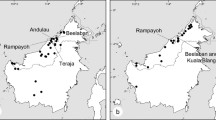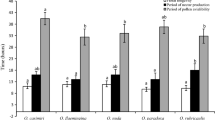Abstract
The pollination biology and breeding systems ofEriotheca pubescens andE. gracilipes have been studied. These two species occur as trees in cerrado vegetation, the neotropical savannas of Central Brazil, with partially sympatric distributions. They have similar phenology and floral structure, although the flowers ofE. pubescens are larger. Both species have nectar flowers pollinated by largeAnthophoridae bees but the main pollinators of each species differ in size. The species have markedly different breeding systems: late-acting self-incompatibility inE. gracilipes and apomixis stimulated by pollination inE. pubescens.
Similar content being viewed by others
References
Baker, H. G., 1960: Apomixis and polyembryony inPachira oleaginea (Bombacaceae). — Amer. J. Bot.47: 296–302.
—, 1973: Evolutionary relationships between flowering plants and animals in american and african tropical forests. — InMeggers, B. J., Ayensu, E. S., Duckworth, W. D., (Eds.): Tropical forest ecosystems in Africa and South America: a comparative review, pp. 145–159. — Washington: Smithsonian Institution Press.
—, 1983: An outline of the history of the anthecology, or pollination biology. — InReal, L., (Ed.): Pollination biology, pp. 7–28. — New York: Academic Press.
—,Baker, I., 1968: Chromosome numbers inBombacaceae. — Bot. Gaz. (Crawfordsville)129: 294–296.
—,Cruden, R. W., Baker, I., 1971: Minor parasitism in pollination biology and its community function: the case ofCeiba acuminata. — Bioscience21: 1127–1129.
Baumgratz, J. F., Silva, N. M. F., 1988: Ecologia da polinização e biologia da reprodução deMiconia stenostachya DC. (Melastomataceae). — Rodriguesia64/66: 11–23.
Bawa, K. S., Bullock, S. H., Perry, D. R., Coville, R. E., Grayum, M. H., 1985: Reproductive biology of tropical lowland rain forest trees. II. Pollination systems. — Amer. J. Bot.72: 346–356.
Buchmann, S. L., 1983: Buzz pollination in angiosperms. — InJones, C. E., Little, R. J., (Eds.): Handbook of experimental pollination biology, pp. 73–113. — New York: Van Nostrand Co.
Cheesman, E. E., 1927: The mechanism of pollen incompatibility inTheobroma cacao. — Ann. Bot. (London)41: 107–126.
Cope, F. W., 1962: The mechanism of incompatibility inTheobroma cacao. — Heredity17: 157–182.
Cruden, R. W., 1977: Pollen-ovule ratios: a conservative indicator of breeding systems in flowering plants. — Evolution31: 32–46.
Duncan, E. J., 1970: Ovule and embryo ontogenesis inBombacopsis glabra (Pasq.)A. Robyns. — Ann. Bot. (London)34: 671–676.
Esquiarte, L., Rio, C. M., Arita, H., 1987: El nectar y el polen como recursos: el papel ecológica de los visitantes a las flores dePseudobombax ellipticum (H. B. K.)Dugang. — Biotropica19: 74–82.
Faegri, K., van der Pijl, L., 1979: The principles of pollination ecology. 3rd edn. — Oxford: Pergamon.
Fedorov, An. A., 1969: Chromosome numbers of the flowering plants. — Leningrad: Acad. Sci. USSR.
Gibbs, P. E., 1988: Self-incompatibility mechanisms in flowering plants: some complications and clarifications. — Lagascalia15: 17–28.
—,Semir, J., Cruz, N. D. da, 1988: A proposal to unite the generaChorisia Kunth andCeiba Miller (Bombacaceae). — Notes Roy. Bot. Gard. Edinburgh45: 125–136.
Gottsberger, G., 1986: Some pollination strategies in neotropical savannas and forests. — Pl. Syst. Evol.152: 29–45.
—, 1989: Beetle pollination and flowering rhythm ofAnnona spp. (Annonaceae) in Brazil. — Pl. Syst. Evol.167: 165–187.
Grant, V., Grant, K. A., 1965: Flower pollination in thePhlox family. — New York: Columbia University Press.
Gribel, R., 1988: Visits ofCaluromys lanatus (Didelphidae) to flowers ofPseudobombax tomentosum (Bombacaceae): a probable case of pollination by marsupials in Central Brazil. — Biotropica20: 344–347.
Haber, W. A., Frankie, G. W., 1982: Pollination ofLuehea (Tiliaceae) in Costa Rican deciduous forest. — Ecology63: 1740–1750.
Jacob, V. J., 1973: Self-incompatibility mechanism inCola nitida. — Incompat. Newsl.3: 60–61.
Johansen, D., 1940: Plant microtechnique. — New York: McGraw-Hill.
Kaur, A., Ha, C. O., Jong, K., Sands, V. E., Chan, H. T., Soepadmo, E., Ashton, P. S., 1978: Apomixis may be widespread among trees of the climax rain forest. — Nature271: 440–442.
Levin, D. A., Kerster, H. W., 1967: Natural selection for reproductive isolation inPhlox. — Evolution21: 679–687.
Maglio, C. A. F., Forni-Martins, E. R., Cruz, N. D. da, 1984: I.O.P.B. Chromosome number reports LXXXIV. — Taxon33: 536–539.
Marshall, A. G., 1983: Bats, flowers, and fruit: evolutionary relationships in the Old World. — Biol. J. Linn. Soc.20: 115–135.
Martin, F. N., 1959: Staining and observing pollen tubes in the style by means of fluorescence. — Stain Technol34: 125.
Miège, J., Burdet, H. M., 1968: Etude du genreAdansonia L. I. Caryologie. — Candollea29: 457–475.
Morawetz, W., 1986: Remarks on the karyological differentiation patterns in tropical woody plants. — Pl. Syst. Evol.152: 49–100.
Mosquin, T., 1971: Competition for pollinators as a stimulus for evolution of flowering time. — Oikos22: 398–402.
Nettancourt, D. de, 1977: Incompatibility in angiosperms. — Berlin: Springer.
Oliveira, P. E., Sazima, M., 1990: Pollination biology of two species ofKielmeyera (Guttiferae) from Brazilian cerrado vegetation. — Pl. Syst. Evol.172: 35–49.
Opler, P. A., Baker, H. G., Frankie, G. W., 1975: Reproductive biology of some Costa RicanCordia species (Boraginaceae). — Biotropica7: 234–247.
Primack, R. B., 1987: Relationships among flowers, fruits, and seeds. — Ann. Rev. Ecol. Syst.18: 409–430.
Rao, C. V., 1954: A contribution to the embryology ofBombacaceae. — Proc. Ind. Acad. Sci.39: 51–75.
Ratter, J. A., 1985: Notas sobre a vegatação da Fazenda Agua Limpa. — Edinburgh: Royal Botanic Garden.
Renner, S. S., 1989: A survey of reproductive biology in neotropicalMelastomataceae andMemecylaceae. — Ann. Missouri Bot. Gard.76: 496–518.
Richards, A. J., 1986: Plant breeding system. — London: George Allen & Unwin.
Robyns, A., 1963: Essai de monographie du genreBombax s.L. (Bombacaceae). — Bull. Jard. Bot. Etat Brux.33: 1–315.
Schemske, D. W., 1981: Floral convergence and pollinator sharing in two bee-pollinated tropical herbs. — Ecology62: 946–954.
Seavey, S. R., Bawa, K. S., 1986: Late-acting self-incompatibility in angiosperms. — Bot. Rev.52: 195–219.
Snow, R., 1963: Alcoholic hydrochloric acid-carmine as a stain for chromosomes in squash preparation. — Stain Technol.38: 9–13.
Stiles, F. G., 1975: Ecology, flowering, phenology, and hummingbird pollination of some Costa RicanHeliconia species. — Ecology56: 285–301.
Stratton, D. A., 1989: Longevity of individual flowers in Costa Rican cloud forest: ecological correlates and phylogenetic constraints. — Biotropica21: 308–318.
Taroda, N., Gibbs, P. E., 1982: Floral biology and breeding system ofSterculia chicha St. Hil. (Sterculiaceae). — New Phytol.90: 735–743.
Van Heel, W., 1966: Morphology of the androecium inMalvales. — Blumea13: 177–394.
Author information
Authors and Affiliations
Rights and permissions
About this article
Cite this article
Oliveira, P.E., Gibbs, P.E., Barbosa, A.A. et al. Contrasting breeding systems in twoEriotheca (Bombacaceae) species of the Brazilian cerrados. Pl Syst Evol 179, 207–219 (1992). https://doi.org/10.1007/BF00937597
Received:
Revised:
Accepted:
Issue Date:
DOI: https://doi.org/10.1007/BF00937597




